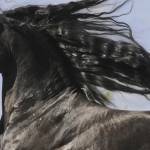Vaulting: Gymnastics on Horseback

Controlled by the subtle cues of a person in the center, the huge draft horse canters in a steady circle. A lithe figure runs toward the horse, springs onto his back, and begins to perform a series of graceful athletic movements. Coordinating with the loping motion, the rider first sits and then kneels, stands, and spins through a pattern of exercises. From a final handstand, the rider pushes high into the air, turns, and lands outside the circle as the horse canters on, completely unruffled by the shifting weight of the flying gymnast. This is vaulting, the new equestrian sport with a 2000-year history.
Long before the Federation Equestre Internationale (FEI) took vaulting under its official wing in 1983, riders were performing gymnastic exercises on moving horses. The roots of this sport are hidden somewhere between ancient Roman festival entertainment and the training of knights in the middle Ages. Noblemen mastered artistic and athletic riding skills during the Renaissance period, and children throughout history have probably been at least as creative as today’s bold young equestrians in coming up with eccentric ways to clamber aboard, stand up on, and part company with their patient ponies.
Like some other equestrian disciplines, vaulting was mostly the province of the cavalry until the middle of the twentieth century, and in 1920 the Olympic Games included vaulting when officers competed in what was known as “artistic riding.” As tanks replaced horses in military importance, there was a modest swell of public interest in vaulting as a way to introduce children to riding. In Germany, the cradle of modern vaulting, the first national team championship was held in 1963, and a championship for individual competitors followed 20 years later. An American visitor to Germany brought the sport to California’s young riders in 1956, and ten years later the American Vaulting Association was established. The organization now boasts about 60 vaulting clubs and over 1000 members in the U.S. and Canada.
The Vaulting Committee of the FEI oversees international rules and competitions in more than 20 countries, and the International Vaulting Club, a nonprofit organization, disseminates information and promotes the sport. Vaulters have developed slightly different procedures and practices in each country, and an established set of rules for world championships allows the competition to be conducted in a standardized way.
A horse used for vaulting may be of any breed. Strength, a calm temperament, and steady gaits are the most important attributes. Animals with draft or warmblood breeding are popular choices, and Morgans, Appaloosas, Thoroughbreds, Quarter Horses, and other breeds have also been used. The horse wears a back pad, a surcingle with two hand grips, and side reins as he trots or canters in a circle 12 to 15 meters or more in diameter. The person in the center holds a longe line (pronounced “lunge,” the French term for “long tether”) attached to the bridle or bit ring. The longeur’s job is to keep the horse moving evenly at the selected gait.
Beginners may practice basic moves on a vaulting barrel, a stationary apparatus equipped with a pad and hand grips. Team moves and formations are also perfected on the barrel, an option that avoids the need for either horse or longeur. The barrel can be used whenever weather conditions prevent safe use of a horse, and some vaulting clubs schedule competitive “barrel meets” during the winter and early spring. Mounted competitions are arranged for vaulters of all skill levels, with the youngest or least experienced participants going through their exercises on a trotting horse. The canter is used by more advanced vaulters and is the gait required for all international competition
Vaulters in individual competition perform compulsory figures and also a kur, or freestyle event, in which ability and artistic interpretation are considered. Team competition involves eight vaulters riding two or three at a time and incorporating lifts and group movements. In the pas de deux, one male and one female vaulter perform kurs showing harmony and cooperation between the vaulters.
For all divisions, a rigorous scoring system deducts points for stiffness, loss of balance, or incorrect position. Vaulters are rewarded for strength, flexibility, body control, and use of movements with a high degree of difficulty. Aspects of the performance that might enhance the score are a variety of positions (facing backward, forward, or to either side of the horse and moving to the neck or croup for some movements), more difficult elements (those with fewer or less secure points of contact with the horse), and creativity in fitting the movements of vaulters and horse to the musical accompaniment. Sensitivity to the comfort and well-being of the horse is also considered as a component of the performance.
Some United States Pony Clubs include vaulting in their programs, and other equestrians or gymnasts are introduced to the sport by friends who belong to a local or regional vaulting club. Clubs offer trained horses, instruction, and a chance to try the sport. Members typically pay dues to share the cost of training and equipment.
To learn more about vaulting or to find a club in your area, contact the American Vaulting Association,8205 Santa Monica Blvd. #1-288, West Hollywood, CA 90046, or call 323-654-0800.








